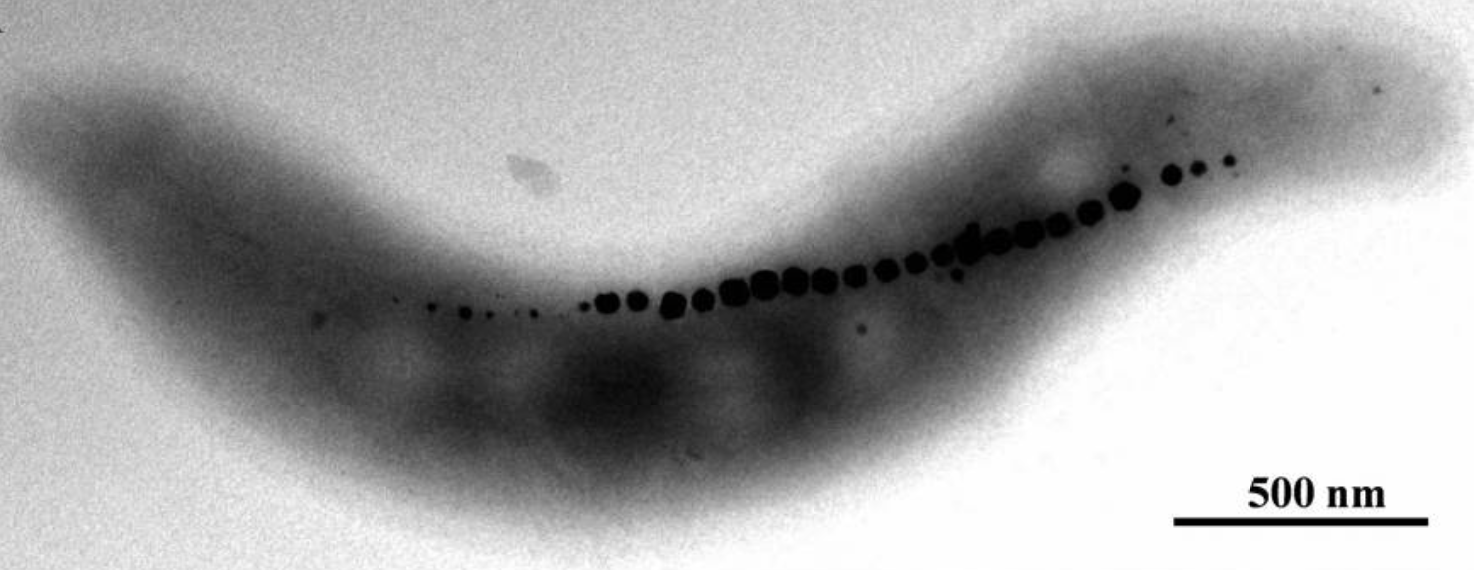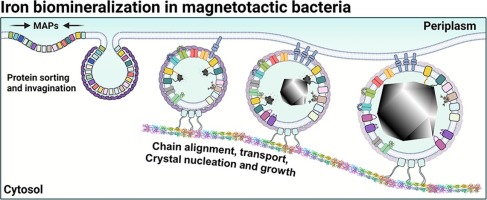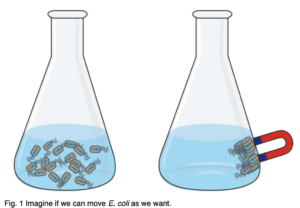41 Arash Komeili – Magnetosomes in bacteria, fish, pigeons, termites, and human brains
Zoë Soon
 Arash Komeili
Arash Komeili
Let’s look at the works of Dr. Arash Komeili as a starter to today’s topic of prokaryotes. Dr. Komeili earned his bachelor’s in Biology at the Massachusetts Institute of Technology in 1996. He then pursued his Ph.D. from the University of California at San Francisco in 2001 and became an assistant professor at UC Berkeley in 2005.
He has made fascinating findings in the field of prokaryotes, which include his research on magnetosomes in bacteria by specifically studying Magnetotactic Bacteria (MB).
MBs were found in Italy by Salvatore Bellini (1963) and Richard Blakemore (Woods Hole Oceanographic Institution, Woods Hole, Massachusetts) almost 40 years ago (in 1975). Flagellated bacteria from a nearby swamp were found to always swim north in a drop of water on a microscope slide. These bacteria will reverse direction if the local magnetic field is reversed. they were found to be able to block out the stimuli given to them by the environment, be it light or pheromones. They were found to be able to navigate in a straight-line based on the geographical locations of the earth.
Richard Blakemore’s discovery was the finding of magnetosomes inside such bacteria.
Magnetosomes are organelles that have lipid bilayer membranes, embedded with transmembrane proteins and contain magnetite (iron compound) crystals. Magentosomes align next to each other forming chains, based on the earth’s magnetic field. They create a magnetic dipole (North and a South pole) that lets them move.
The crystalline magnetic minerals of magnetosomes are made up of three irons and four oxygen groups (Fe3O4 or Fe3S4. This is the exact composition found in regular magnets. MBs use magnetosomes to navigate (magneto-aerotaxis) to the microaerophilic environments in which they thrive, often in the mud, sediment, or specific layer of a water column within various aquatic environments.
Interestingly, magnetosomes are also in the human brains, fish, termites, and pigeons. However, their functions within these organisms are not exactly known.
 (Lefèvre, 2013)
(Lefèvre, 2013)
One way magnetosomes can stay in place is with the help of filaments that anchor them. Dr. Komeili and his team were able to obtain microscopic images of these filaments and find out how they make cells behave like motile compasses.
The filament composition of these bacteria made it possible for these and many other MB species to find and maintain the proper membranous shape. These filaments are only distantly related to the ones found in mammalian bodies in that each filament is only designed for a specific task rather than being versatile, as observed in the mammalians’ filaments. Filaments found in MB species are also ATPases, meaning they can break ATP into ADP and Pi and use the released energy to help them bind and perform their designated tasks.
Another interesting finding was that the biomineralization and formation of magnetites didn’t happen in the observed bacteria until appropriate mineral and low oxygen conditions were met.
Magnetosomes are organelles that aren’t widely known and talked about because of the very few species there are, so research in this field is quite fascinating as the pieces of information learned are very novel. Other animals, such as pigeons, bats, turtles, salmon, rays and sharks can sense a local magnetic or electrical field (magnetoreception) in order to navigate or find prey (NY Times, 1981). It is unclear on the extent of similarities that may exist between magnetoreception and prokaryotic magneto-taxis.
Here is an awesome picture to show how this is done step by step in a cell:
 (Shimon, 2021)
(Shimon, 2021)
The above figures shows how the minerals (coloured black in the diagram) are being brought into the cell and made into bigger pieces as they are being transported to their correct places in the cell via the microtubules.
The research into magnestomes has created many more questions yet to be answered. These include:
- Which genes are required for the formation and function of the bacterial magnetosome and their associated filaments? How similar are these genes to those of other organisms?
- What role do magnetosomes perform in the human brain?
- How did some eukaryotes develop the ability to biomineralize material and make magnets?
- Can functional magnetosomes and their associated filaments be created in cells (prokaryotes or eukaryotes) that don’t already have them? and can this by done biologically or synthetically?
- When did the MBs emerge and to what polygenetic tree did its ancestors belong to?

(iGem, 2014)
References
– Ben-Shimon, S., Stein, D., & Zarivach, R. (2021). Current view of iron biomineralization in magnetotactic bacteria. Journal of Structural Biology: X, 5, 100052. https://doi.org/10.1016/j.yjsbx.2021.100052
– Bergeron, J. R. C., Hutto, R., Ozyamak, E., Hom, N., Hansen, J., Draper, O., Byrne, M. E., Keyhani, S., Komeili, A., & Kollman, J. M. (2017;2016;). Structure of the magnetosome‐associated actin‐like MamK filament at subnanometer resolution. Protein Science, 26(1), 93-102.
https://doi.org/10.1002/pro.2979
– Imagine if we can move E. coli as we want. (2014). https://2014.igem.org/Template:Kyoto/Project/Magnetosome_Formation/content. photograph. Retrieved July 25, 2023, from https://2014.igem.org/Template:Kyoto/Project/Magnetosome_Formation/content.
– Komeili, A. (n.d.). Arash Komeili. Plant & Microbial Biology | University of California, Berkeley. Retrieved August 3, 2022, from https://plantandmicrobiology.berkeley.edu/profile/komeili
– Komeili, A. (2012). Molecular mechanisms of compartmentalization and biomineralization in magnetotactic bacteria. FEMS Microbiology Reviews, 36(1), 232-255.
https://doi.org/10.1111/j.1574-6976.2011.00315.x
– Lefèvre, C. T., Bennet, M., Landau, L., Vach, P., Pignol, D., Bazylinski, D. A., Frankel, R. B., Klumpp, S., & Faivre, D. (2014, July 15). Diversity of magneto-aerotactic behaviors and oxygen sensing mechanisms in cultured magnetotactic bacteria. Biophysical journal. https://www.ncbi.nlm.nih.gov/pmc/articles/PMC4104051/
– Lefèvre, C. T., & Bazylinski, D. A. (2013). Ecology, diversity, and evolution of magnetotactic bacteria. Microbiology and Molecular Biology Reviews, 77(3), 497-526.
https://doi.org/10.1128/MMBR.00021-13
– Lefèvre, C., Bennet, M., Landau, L., Vach, P., Pignol, D., Bazylinski, D., Frankel, R., Klumpp, S., & Faivre, D. (2014). Diversity of magneto-aerotactic behaviors and oxygen sensing mechanisms in cultured magnetotactic bacteria. Biophysical Journal, 107(2), 527-538.
https://doi.org/10.1016/j.bpj.2014.05.043
– Mark, S. (2020). Arash Komeili and his student studying the magnetic properties of unusual aquatic bacteria that dissolved iron and use it to navigate along the earth’s magnetic field. [Photograph]. Berkeley Research News.
https://vcresearch.berkeley.edu/news/mining-microbe-animal-magnetism
– Sullivan, W. (1981, June 14). Tests of magnetic bacteria illuminate polarity’s role. The New York Times. https://www.nytimes.com/1981/06/14/us/tests-of-magnetic-bacteria-illuminate-polarity-s-role.html
(More Pictures can be found here:)
https://www.researchgate.net/figure/Magnetosomes-in-M-gryphiswaldense-A-TEM-micrograph-of-a-wild-type-cell-of-M_fig1_350928181

